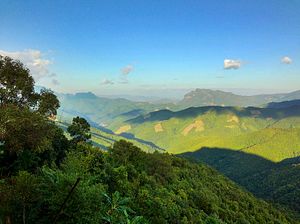The latest iteration of the Lao Coffee Festival, which took place in April in the Lao capital of Vientiane, featured various activities, including free coffee tasting, barista competitions, latte art, and musical performances, and even three ladies dressed up as “coffee goddesses” welcoming visitors at the front gate.
Beyond these individual events, the Festival also reinforced the growing significance of the coffee industry in Laos and the tiny, landlocked Southeast Asian state’s aspirations to become a major player in this area despite the challenges that remain.
The aggregate figures are small but growing. Laos’ coffee exports topped $74 million in the first six months of 2017, an increase of $50 million compared to the same period in 2016. The Lao Coffee Association projected that the value of coffee exported by Laos was expected to exceed $112 million in the 2017 fiscal year, an increase of 3 percent compared to the previous year.
Although the Association has not revealed the latest figure, it is evident that Laos is selling more coffee to the outside world than before, and that is something that is being encouraged.
The role of coffee in Laos is far from new. The first coffee farm in Laos was reportedly created during the French colonial period in the early 20th century. But decades of war and bombing destroyed the nascent coffee industry. During the Vietnam War from 1964 to 1973, the United States dropped more bombs on Laos than it used during World War II.
Bolaven Plateau in Champasak Province, where most coffee trees were planted, was also destroyed by the bombs of that time and still has a risk of unexploded ordinance. This has left coffee farms in Laos as small, individual producers who are less competitive in terms of introducing the latest farming equipment and techniques. It is said there are between 15,000 and 20,000 smallholder farmers up and running around Bolaven Plateau.
However, signs of changes have emerged with the increasing demands from neighboring countries, especially China and Vietnam. Vietnam, for instance, imports about 50 percent of Laos’ total Arabica coffee output, or 30,000 tons, every year, and the figure is steadily increasing.
This made the Lao government realize the huge potential offered by the country’s coffee industry if it is fostered as a staple product, which could also help boost the country’s economy. Little surprise then that various government-backed measures have been introduced to support coffee farms across the country.
The 2+3 policy is one of the latest. The government initiative encourages investors and landowners to partner in industrial tree plantations. It is a framework where farmers must provide land and labor while investors provide funding, technical support, and a ready market for growers.
Coffee is also being included as part of wider socioeconomic development goals set up by the Lao government in an effort to boost domestic firms’ overseas expansion. For instance, under these initiatives, the Dao-Heuang Group, one of the largest coffee producers in Laos, signed an agreement recently with China’s Kunming Kanglin Food Import and Export Trading in coffee exports to China. The agreement will allow the group to expand the gross sales of its coffee products on the world market, especially in China.
The Lao government has recently set up a goal of 2.8 percent growth in agricultural and forestry sectors in 2018. For coffee, that includes domestic sales and exports amounting to no less than 137,500 tons.
While challenges remain, there are clear efforts underway to realize the Lao government’s efforts to boost the coffee industry. Apart from the initiatives from the government itself, farmers are doing their part as well by putting efforts into enhancing the quality of coffee beans and diversifying the types of coffee beans they produce in order to appeal to a broader range of customers.
According to the Coffee Research Experiment Center in Laos, about 80 percent of coffee beans produced in Laos are Robusta coffee while the rest is Arabica. Robusta is one of the most widely produced coffee beans in the world and is commonly used to produce instant coffee mix. This means Laos still heavily depends on economies of scale by exporting lower priced coffee beans.
Hoang Van Thuy, general director of Ho Chi Minh City-based coffee manufacturing and supplying company Dai Hoang Thuy, said that his company imports Robusta coffees from Laos to mix them with others thanks to their low price. In contrast, since the production of Arabica coffees is limited in Vietnam, the company needs to import more from outside to satisfy domestic demands, Hoang noted.
Aware of this external demand, coffee farmers in Laos are increasing their efforts to produce more Arabica coffee while some are producing Kopi Luwak coffee beans. Since Kopi Luwak coffee includes part-digested coffee cherries eaten and defecated by the Asian palm civet, the supply of higher-priced versions is limited and is traded at expensive price tags on the international coffee market.
To be sure, Laos still has a long way to go if it intends to emerge as a major Asian coffee giant. For instance, Indonesia, one of the largest coffee bean producers in Southeast Asia, is already currently leading Kopi Luwak production, and has received international attention in this respect. Other Southeast Asian states as well have seen the further growth of a coffee culture in recent years that have further driven interest in the industry. Nonetheless, Laos remains a small but determined newcomer in this space and one that will remain interesting to watch.

































